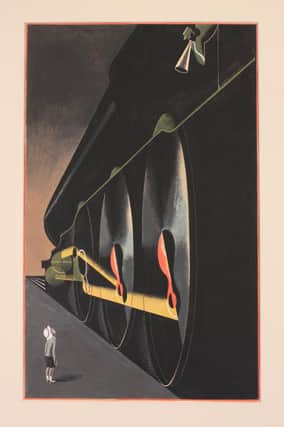Iconic Flying Scotsman poster to be displayed at National Museum of Scotland


It has become one of the most iconic train services in Europe, and was the epitome of luxury travel between the wars.
The Flying Scotsman service between Edinburgh and London is an iconic representation of speed, industry and modernity.
Advertisement
Hide AdAdvertisement
Hide AdThese were the traits embodied by the iconic 1932 advertising campaign ‘Take me by the Flying Scotsman’, whose original artwork has now been purchased by National Museums Scotland.
The painting by A R Thomson will go on display in the National Museum of Scotland.
It shows the enormous, gleaming wheels and engine of the Flying Scotsman with a child standing on the adjacent platform looking up in awe at the driver.
It read: “Take me by the Flying Scotsman Leaves Kings Cross at 10am weekdays. With apologies to the Southern Railway.”
Advertisement
Hide AdAdvertisement
Hide AdThe poster was a cheeky pastiche of an existing Southern Railway campaign, which showed a child talking to an engine driver and saying: "I'm Taking an Early Holiday cos I know Summer Comes Soonest in the South".
LNER wanted to project a different image of speed and modernity, mocking Southern Railway’s homely style.
The age of railway art as a serious field of commercial design took off in the 1920s and reached its peak in the 1930s.
Before the First World War railway posters were text-heavy, cramming in as much information about a service and its destination as possible.
Advertisement
Hide AdAdvertisement
Hide AdIn the 1920s LNER took the progressive step of hiring an advertising manager and introducing a poster campaign.
The company soon had a reputation for producing exciting and innovative work.
LNER kept five artists on exclusive contract from 1926 until 1932 and commissioned a new typeface.
When the contracts expired in 1932, the company approached A R Thomson to create new works.
Advertisement
Hide AdAdvertisement
Hide AdThe poster in question was not as popular with the public as the Southern Railway design, but was recognised for its provocative design value.
The Flying Scotsman express passenger service rain daily at 10am between London and Edinburgh from 1832.
The locomotive which was named after the service was built in Doncaster for LNER in 1923.
It was designed by Sir Nigel Gresley as part of the A1 class – the most powerful steam locomotives used by the railway. By 1924, when it was selected to appear at the British Empire Exhibition in London, it had been given the name The Flying Scotsman.
Advertisement
Hide AdAdvertisement
Hide AdMeredith Greiling, Senior Curator of Transport at National Museums Scotland said: “This striking artwork evokes the obsession with speed, industry and modernity which influenced graphic design in the twenties and thirties.
"An iconic image which broke new ground when it was created, it’s a beautiful reminder of a golden age of rail travel.
"This is an important addition to our internationally significant railway collection and we are grateful to Art Fund and the NMS Charitable Trust for their support.”
Sarah Philp, director of Programmes and Policy, Art Fund, said: "This painting, which portrays the famous Flying Scotsman train as the thrilling embodiment of modernity and speed, is a remarkable addition to National Museums Scotland’s wonderful transport collection.
Advertisement
Hide AdAdvertisement
Hide Ad"I know it will captivate visitors, and we are delighted to have supported this important acquisition."
Thank you for reading this story on our website. While I have your attention, I also have an important request to make of you.
The dramatic events of 2020 are having a major impact on many of our advertisers - and consequently the revenue we receive. We are now more reliant than ever on you taking out a digital subscription to support our journalism.
Subscribe to the Edinburgh Evening News online and enjoy unlimited access to trusted, fact-checked news and sport from Edinburgh and the Lothians. Visit https://www.edinburghnews.scotsman.com/subscriptions now to sign up.
By supporting us, we are able to support you in providing trusted, fact-checked content for this website.
Joy Yates
Editorial Director